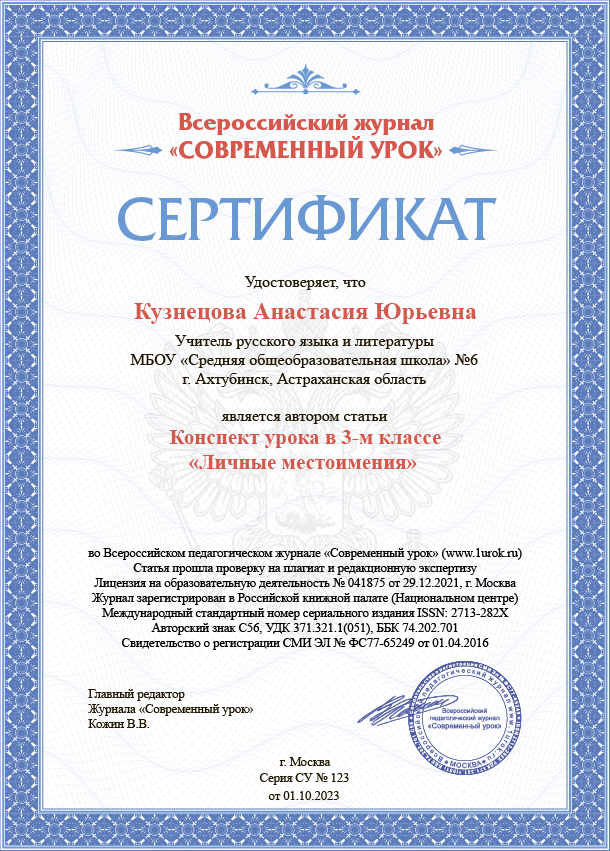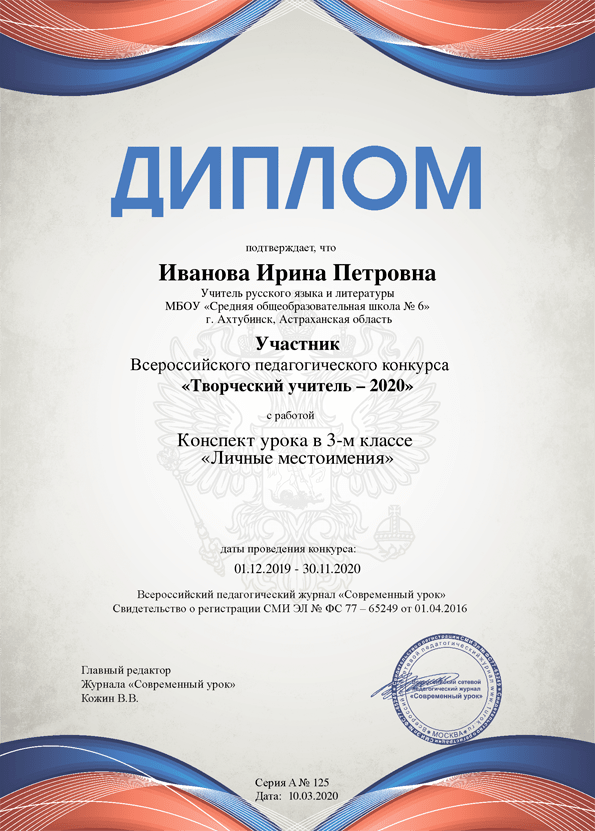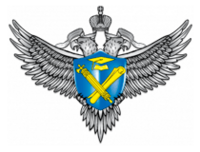План-конспект «Spotlight» 5. Одевайтесь правильно
Автор: Бабенко Татьяна Геннадиевна
Организация: ГБОУ ЛНР МСШ№7 им. О.В.Кошевого
Населенный пункт: г.Молодогвардейск
Предмет: английский язык УМК «Spotlight» (В. Эванс, Д. Дули, О.Подоляко, Ю. Ваулина.)
Класс: 5 класс
Тема: Одевайтесь правильно (Dress right) .УМК Spotlight 5 Module 7
Тип: урок комплексного применения знаний и умений
Цели урока:
Активизация ранее изученной лексики по теме «Одежда».
Введение новой лексики по теме «Одежда».
Закрепление лексики на базе использования времен Present Simple и Present Continuous
Задачи:
обучающие:
- совершенствование умений употреблять знакомые и новые лексических единиц по теме «Погода. Одежда. Занятия в разное время года»;
-совершенствование умений описывать картинки;
- формирование навыков поискового чтения;
-формирование умений ознакомительного чтения и аудирования с пониманием основного содержания текста;
развивающие:
- развитие навыков и умений во всех видах речевой деятельности;
- развитие умений распознавать и употреблять в речи временные формы глагола Present Continuous and Present Simple;
- развитие умения работать в парах, группе
воспитательные:
- содействие воспитанию правильного выбора одежды в соответствии с погодой;
- содействие воспитанию полезного выбора занятий в разное время года.
Планируемые результаты:
Личностные УУД:
освоение обучающимися социального опыта, основных социальных ролей, правил поведения, осознание важности знаний в жизни человека и общества;
формирование коммуникативной компетентности в общении и сотрудничестве со сверстниками.
уважительного отношения к другому человеку
Регулятивные УУД
расширение лексического запаса;
дальнейшее овладение общей речевой культурой, слушать собеседника и вести диалог;
активизация изученного материала для работы с текстом, с аудиозаписью;
Познавательные УУД
умение ставить цели, анализировать информацию;
определение основной и второстепенной информации;
самостоятельное решение проблем творческого и поискового характера.
Коммуникативные УУД
умение вступать в речевое общение и сотрудничать со сверстниками в группах, в парах, умение с достаточной полнотой и точностью выражать свои мысли в соответствии с задачами и условиями коммуникации; владение монологической и диалогической формами речи в соответствии с грамматическими и синтаксическими нормами языка.
Формы работы: Фронтальная работа, работа в парах, в группах, индивидуальная работа
Формы контроля: фронтальный, индивидуальный, групповой.
Виды деятельности: Аудирование, чтение, монологическая речь, диалогическая речь, письмо.
Оборудование: ноутбук, проектор, презентация на тему «Погода. Одежда», аудиозаписи к учебнику, фото людей в разной одежде в разную погоду
Ход урока.
1.Организационный момент
Teacher: Good morning, children! Let’s smile at each other and say good wishes. I wish you good luck!
2. Сообщение темы урока. Лексическая разминка
Teacher: Today we have an unusual lesson but I don’t tell you the theme of our lesson you have to guess it and for the first you have to start a lesson warming up stage. Please, pay your attention to warming up stage. We’ll have to brush up and train the most difficult sounds (th) [ ð] [θ]. Repeat the sound after me.
[ θ] (th). think, thank, thick, thought, thumb, thing
[ ð] (th). that, then, these, those, they, weather, clothes, northern, rather, southern
Repeat the tongue-twister:
These clothes are rather for the southern weather,
those clothes are rather for the northern weather
Teacher: I’d like to know your opinion how do you understand the tongue-twister?
Pupil 1: We need different clothes.
Pupil 3: In winter people have to wear warm clothes
Pupil 4: In summer we usually wear clothes for hot weather.
Teacher: Okay. After warming up stage you have to guess what is the new theme of our lesson. Look at the pictures on your desks. Who can say?
Pupil 5: Maybe about clothes
Pupil 6: I think it is about different weather and clothes
Teacher: Sure. Today we are going to talk about different clothes in different weather.
3.Проверка домашнего задания. Write a short telephone conversation about the weather. What the weather like today? P.87, ex.7
4.Сообщение нового материала.
Teacher: Well done! Open your book to page 88, where you can find ex 1. Look at the pictures and say what clothes you know.
Pupil 7: I know T-shirt, shorts, socks, trainers, blouse
Pupil 8: I know blouse, trousers, shirt, suit, dress.
Pupil 9: I know jumper, jeans.
Teacher: Great! Which of them are new for you?
Pupil 10: high heels and gloves.
Teacher: Which clothes are for warm or cold weather? As you are divided into two groups you have different tasks
The first group writes the clothes for warm weather. The second group writes the clothes for cold weather. Let’s fill this table together (Teacher shows the pictures)
|
Warm weather |
Cold weather |
|
|
|
Pupil work in groups and give their answers.
|
Warm weather |
Cold weather |
|
Cap, T-shirt, shorts, socks, trainers, blouse, trousers, high heels, shirt, suit, dress, sandals, jeans, skirt |
Jacket, hat, gloves, scarf, coat, trousers, suit, boots, shoes, jumper, jeans |
5.Введение новой лексики.
Teacher: Wonderful! To describe the people’s clothes better let’s learn and match some opposites. Ex.2, p.88 Who wants to say?
Pupil 11: long and short
Pupil 12: heavy and light
Pupil 13: tight and loose
Teacher: Try to describe the people’s clothes use the sentences:
- for the first group:
1.Angela is wearing a long skirt,… It seems to be warm outside
2. Billy is wearing a light T-shirt,… It seems that he is going to play football
- for the second group:
1.Oliver is wearing a heavy jacket,… It seems to be cold outside
2. Max is wearing a long coat,… It looks like raining
Teacher: Nice! What people can do with clothes? (Teacher shows the presentation. Children read sentences and understand their meaning from the pictures)
We can put on clothes
We can take off clothes.
We can wear clothes
We can iron clothes.
We can clean or wash clothes
We can buy or sell clothes.
We can talk about the clothes
Teacher: Great! Continue the sentences:
If the weather is hot you will put on….
If the weather is rainy you will put on….
If the weather is frosty you will put on….
If the weather is warm you will put on….
Teacher: I hope you’ve learnt to choose right clothes for the different weather. Now let’s learn how to ask about clothes and answer the questions. Please, open your book to page 88 where you can see ex.3. We can ask about clothes using these phrases. The pupils of the first group read the phrases and try to guess their meaning. (учитель помогает с переводом при возникновении затруднений)
Pupil 14: How do I look in this? – Как я выгляжу в этом?
Pupil 1: How does this look on me? – как это выглядит на мне?
Pupil 2: What do you think of me (dress)? – Что ты думаешь о моем (платье)?
Pupil 3: Do I look all right in this? – Я выгляжу нормально в этом?
Teacher: Great! Now we are ready to listen to the second group. (учитель помогает с переводом при возникновении затруднений)
Pupil 4: It/They look(s) great/ fabulous on you. – Это сидит на тебе превосходно.
Pupil 5: You look lovely/great/ - Ты выглядишь здорово.
- 6: It/ they suit(s) you perfectly. – Это идет тебе превосходно.
Pupil 7: I’m not sure it/they suit(s) you. – Я не уверен, что это тебе идет.
Pupil 8: That/Those look(s) terrible on you – Выглядит ужасно на тебе.
Teacher: So, work in pairs, ask and answer the questions using the phrases in the table as in the example. Do it in writing form, please.
(Children read their dialogues.)
6. Физкультминутка
Teacher: Please, stand up, children, and do my commands. Show me how do you put on and take off your clothes. Учащиеся выполняют команды (put on/ take off/ iron/ wash or clean)
Teacher: Sit down, my dear. Now try to understand when we should use the present simple and the present continuous. Look at ex. 6a), p.89 read sentences and analyze the form of the verbs.
Pupil 9: I think we use Present Simple when we talk about habits/routines. (She always wears boots in winter)
Pupil 10: I guess we use Present Continuous when we talk about actions happening now. (She is wearing a raincoat now)
Teacher: Yes, you are right. We use Present Continuous when we talk about actions happening now and when we describe actions in the pictures. Do ex.6b) and explain why you use the present simple or the present continuous.
7. Применение знания
Teacher: Look at the pictures. Answer the questions and describe the people’s clothes. (Teacher shows some pictures)
Is he wearing a dress?
Is he wearing boots?
Are they wearing suits?
Are you wearing a coat now?
Am I wearing jeans?
What do you wear in winter?
What do you wear in summer?
What do you wear in spring?
What do you wear in autumn?
How often do you wear gloves? socks? jumper? shirt? tie?
8. Развитие навыков аудирования и чтения.
Teacher: Let’s look at the telephone conversation in ex. 4, p. 89. You are going to listen to it. Please, get ready.
Good. There are some new words for you. Let’s repeat them after me.
Ok! Let’s read it and translate.
Well done! So, where is Patsy? Where is she going?
Pupil 11: Patsy is at the airport and getting on the plane now. She is going to Glasgow.
Teacher: Listen to some people, please, and answer the questions:
- What’s the weather like?
- What’s Jennifer wearing?
- Which tie hasn’t Andrew got?
Look at page 89, ex 8, tick the correct answer.
Pupil 12: It’s cloudy in London. This is the picture C.
Pupil 13: Jennifer is wearing the short orange dress. This is the picture B.
Pupil 14: Andrew hasn’t got a brown tie. This is the picture C.
9. Рефлексия учебной деятельности.
Teacher: How do you feel about our lesson? Choose a picture which express your feelings at our lesson. Give me your impression about the lesson. Have you been successful? Well, you’ve been very active and productive today.
(Дети говорят, что нового узнали, что умеют, используя шаблоны на доске: Now I can…. Now I know….)
10. Домашнее задание.
Teacher: Open your diaries and write down your home task. Ex.9, p.89, find pictures of your family and friends, write a short description of each picture using the prompts. Our lesson is over. Thank you for your job. Good bye.








